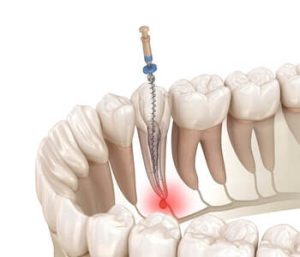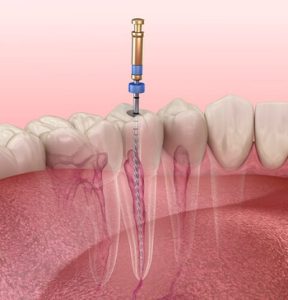A root canal treatment often sounds daunting, but for most people, it’s the only way to relieve the severe pain of an infected tooth and save it from extraction. But what actually happens in a root canal before and after the treatment? This guide walks you through everything you need to know about root canal therapy and what you can expect at each stage.
What Exactly is a Root Canal Treatment?
Root canal treatment is a widely performed dental procedure developed to save and restore an infected or damaged tooth. The process involves extracting the infected pulp, which houses the nerves and blood vessels, thoroughly cleaning and disinfecting the root canal system, and sealing it to avoid future infections. This treatment effectively relieves intense pain caused by a tooth infection and helps avoid tooth extraction.
Recognising the Signs: When Do You Need a Root Canal?
You might need a root canal if you’re experiencing any of the following symptoms:
- Severe toothache that doesn’t go away
- Ongoing tooth sensitivity to hot or cold foods and beverages that don’t subside.
- Swollen gums or facial swelling around the affected tooth
- Pain when biting or chewing
- Darkened or discoloured tooth, indicating pulp damage
- Pimple-like swelling on the gums, which may release pus (a sign of an abscess)
These signs suggest that the tooth pulp inside is inflamed or infected due to deep decay, repeated dental procedures, cracks, or trauma. If untreated, the infection can extend to the bone, surrounding tissues, and nearby teeth, potentially causing severe complications. To avoid further harm, seeing a dentist promptly is crucial if you experience these symptoms.
What Happens Before a Root Canal Procedure?
Once your dentist suspects a tooth infection, they will conduct an examination, often using X-rays to assess the damage inside your tooth. If the tooth pulp is infected, a root canal is advised to extract the diseased tissue, clean and disinfect the root canal system, and then seal the tooth to prevent reinfection and ensure long-term stability.
Preparing for the Procedure
- A comprehensive consultation with the dentist to discuss your symptoms and determine if you need a root canal.
- X-rays to locate the infected pulp and examine the affected tooth’s root structure.
The Root Canal Procedure: What Happens?
A root canal procedure is performed in several steps to completely remove the infected pulp, clean the root canals, and restore the tooth. Here’s a step-by-step breakdown of what happens during the procedure:
1. Numbing the Area
- Your dentist will use a local anaesthetic to numb the affected tooth and surrounding area.
- This ensures you remain comfortable during the procedure.
2. Isolating the Tooth
- A dental dam (a rubber sheet) is positioned around the affected tooth to keep it dry and prevent saliva contamination.
3. Accessing the Pulp Chamber
- The dentist will create a small opening in the tooth to reach the pulp chamber, where the infected pulp and nerves are located.
4. Removing the Infected Pulp
- Specialised instruments are used to remove the diseased pulp, including bacteria, dead nerve tissue, and blood vessels inside the canals of the tooth.
- If the canals are calcified, additional steps may be needed to clean them thoroughly.
5. Cleaning and Shaping the Root Canals
- The root canal system is disinfected to eliminate any remaining bacteria.
- The root canals are carefully reshaped to ensure they are ready for filling.
6. Filling the Canals
- After thorough cleaning, the canals are sealed with a biocompatible material, typically gutta-percha, to block bacteria and prevent reinfection.
7. Placing a Temporary Filling
- A temporary filling is applied over the access opening to protect the tooth until the next visit.
8. Placing a Permanent Crown (Final Step)
- After healing, the dentist replaces the temporary filling with a permanent crown or filling to reinforce the tooth.
- A porcelain crown is often recommended to protect the tooth from further damage or recurrent decay.
 How Long Does the Procedure Take?
How Long Does the Procedure Take?
- A straightforward root canal may be completed in one visit.
- More complex cases, such as those involving four canals in an upper molar, may require two or more visits.
After the procedure, you may experience mild discomfort, but this usually subsides within a few days. Following your dentist’s post-treatment care instructions ensures a smooth recovery and long-term success of the treated tooth.
Root Canal Recovery: What Happens Next?
A root canal treatment effectively removes infection and saves your tooth, but proper aftercare is essential for a smooth recovery and long-term success. Here’s what you can expect after the procedure.
Immediate Recovery: The First Few Days
After the local anaesthetic wears off, you may experience some mild discomfort, but this is normal and temporary. Here’s what you should know:
Common Post-Treatment Symptoms:
- Mild to moderate discomfort around the treated tooth
- Sensitivity when chewing or biting (especially if a temporary filling is placed)
- Slight swelling of the gums near the treated area
- A dull ache or throbbing sensation as the tissue heals
These symptoms usually ease within a few days to a week and can be controlled with over-the-counter pain relief, like ibuprofen or paracetamol.
Dos and Don’ts After a Root Canal
What You Should Do:
- Avoid chewing on the endodontically treated tooth until a permanent crown is fitted.
- Practise good oral hygiene by brushing and flossing gently.
- Stick to soft foods for the first 24–48 hours to prevent irritation.
- Attend follow-up visits to monitor healing and complete the restoration process.
What to Avoid:
- Hard, crunchy, or sticky foods can dislodge or damage the temporary filling.
- Chewing on the affected side until your dentist gives the all-clear.
- Skipping medications if your dentist prescribes antibiotics or pain relievers.
Long-Term Results: Before and After a Root Canal
A successfully treated tooth should function just like any other tooth. Here’s what changes after treatment:
Before a Root Canal:
- The infected tooth is painful and sensitive.
- The pulp inside the tooth is inflamed or necrotic.
- Facial swelling or an abscess may be present.
- Chewing becomes painful, affecting daily activities.
After a Root Canal:
- The infected pulp is removed, eliminating discomfort.
- The tooth is preserved and functions normally after a permanent crown is placed.
- No more swelling or pain, allowing you to eat and speak comfortably.
- The potential risk of further infection or tooth loss is minimised.
Why a Dental Crown is Important After a Root Canal
Since a treated tooth becomes more brittle, especially a front tooth or molar, a dental crown is often recommended to:
- Protect the tooth from fractures or cracks
- Restore full chewing function
- Prevent further decay
Without a crown, the tooth is at risk of damage, so it’s essential to complete the restorative phase of the treatment.
Root Canal or Tooth Extraction: Which One is Right for You?
When faced with a severely damaged or infected tooth, the decision often comes down to saving it with a root canal or removing it with an extraction. Both options have their pros and cons, but the best choice depends on your oral health, long-term goals, and overall dental condition.
Why Choose a Root Canal?
A root canal preserves your natural tooth by removing the infected pulp, cleaning the root canal system, and sealing it to prevent reinfection. This procedure maintains tooth function, jawbone health, and bite alignment, avoiding the complications of missing teeth. It is generally less invasive than extraction, with a quicker recovery. However, a crown is often needed to strengthen the tooth, and in rare cases, reinfection may require further treatment.
When is Tooth Extraction Necessary?
Extraction is the recommended option when a tooth is severely decayed, fractured, or beyond repair. It completely removes infection but leaves a gap, which can cause shifting teeth, jawbone loss, and bite misalignment. While cheaper upfront, replacing the tooth with a dental implant or bridge adds to the overall cost and treatment time.
Which is the Better Option?
If possible, a root canal is preferred as it saves your natural tooth and prevents long-term complications. Extraction is a last resort when a tooth cannot be salvaged, requiring a replacement to restore function. Speak with your dentist to evaluate your condition and select the most suitable treatment for your needs.
How Long Does a Root Canal Last?
A properly treated and well-maintained root canal can last a lifetime. However, its longevity depends on good oral hygiene, regular dental check-ups, and a well-fitted crown if needed. With the right care, your treated tooth can remain strong and functional for years to come.
The Importance of Early Treatment
A root canal helps preserve your natural tooth, eliminating the need for extraction and maintaining your smile’s functionality. If you’re experiencing symptoms like severe toothache, facial swelling, or pain when chewing, don’t delay treatment. Early intervention raises the chances of a successful outcome and reduces discomfort.
When to Contact Your Dentist
While most people recover without complications, contact your dentist if you experience:
- Severe pain that doesn’t improve after a few days
- Excessive swelling or pus discharge near the treated tooth
- A loose or lost temporary filling before your next visit
- A broken or cracked tooth after treatment
Prompt follow-up care ensures that the root canal procedure is successful and that your treated tooth remains in good condition for years to come.
FAQs About Root Canal Treatment
- Can a root canal treatment be completed in one visit?
Yes, in many cases, a root canal can be completed in one visit. However, if the infection is severe or multiple canals need cleaning, a second visit may be required.
- Is there an alternative to a root canal?
The main alternative is tooth extraction, which may require a dental implant, bridge, or denture to restore function. However, a root canal is the preferred choice for preserving your natural tooth whenever possible.
- How soon can I return to normal activities after a root canal?
Most people can return to work or normal activities on the same day. However, you should avoid chewing on the treated tooth until it is fully restored.
- Can I drive myself home after a root canal?
Yes, unless you were given sedation, in which case you may need someone to drive you home. A standard root canal with local anaesthetic does not impair your ability to drive.
- Will my tooth turn dark after a root canal?
A root canal-treated tooth may darken slightly over time due to the removal of the tooth’s nerve. A dental crown or teeth whitening can help restore its natural colour.
- Can I exercise after a root canal?
It’s best to avoid intense exercise for the first 24 hours, as it may cause increased blood flow and discomfort. Light activity is usually fine.
- Can a root canal fail?
While root canals have a high success rate, failure can occur if bacteria remain in the canals, a crack develops, or the restoration is not properly sealed.
- Do root canals weaken teeth?
Yes, because the pulp and blood supply are removed, making the tooth more brittle. A crown is usually recommended to reinforce and protect the tooth.
- What should I do if my temporary filling falls out?
If a temporary filling comes out, contact your dentist immediately to have it replaced. Leaving the tooth exposed can lead to infection or damage.
- Can a root canal be redone if needed?
Yes, a root canal retreatment can be done if the tooth gets reinfected. In more complex cases, an apicoectomy (removal of the root tip) may be necessary to preserve the tooth.
The Bottom Line: Why Root Canal Treatment is Worth It-
 A root canal is one of the most effective ways to save an infected tooth and prevent extraction. By removing the infected pulp, thoroughly disinfecting the canals, and sealing the tooth, it can be fully restored and function normally.
A root canal is one of the most effective ways to save an infected tooth and prevent extraction. By removing the infected pulp, thoroughly disinfecting the canals, and sealing the tooth, it can be fully restored and function normally.
If you’re dealing with severe pain, swelling, or sensitivity, don’t ignore it. Seeking prompt treatment can prevent further complications. With good care, a root canal-treated tooth can endure a lifetime, making a significant difference in your oral health and quality of life.
If you’re experiencing persistent tooth pain or any sign of infection, don’t wait—schedule an appointment today with Beyond Infinity Dental at (02) 8806 3799 to see if a root canal is the right solution for you!
Note: Any surgical or invasive procedure carries risks. Before proceeding, you should seek a second opinion from an appropriately qualified health practitioner.
References
- Medical News Today. (n.d.). Root canal treatment: Everything you need to know. Retrieved from https://www.medicalnewstoday.com/articles/142780
- Healthline. (n.d.). Tooth extraction: What to expect. Retrieved from https://www.healthline.com/health/tooth-extraction
- WebMD. (n.d.). Dental crowns: Uses, types, and what to expect. Retrieved from https://www.webmd.com/oral-health/dental-crowns
- Cleveland Clinic. (n.d.). Oral hygiene: Best practices & importance. Retrieved from https://my.clevelandclinic.org/health/treatments/16914-oral-hygiene
- Colgate. (n.d.). What is a pulp chamber?. Retrieved from https://www.colgate.com/en-us/oral-health/mouth-and-teeth-anatomy/what-is-a-pulp-chamber









